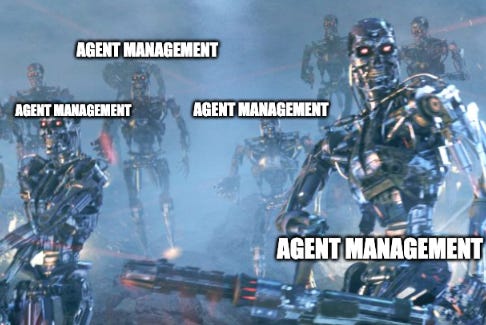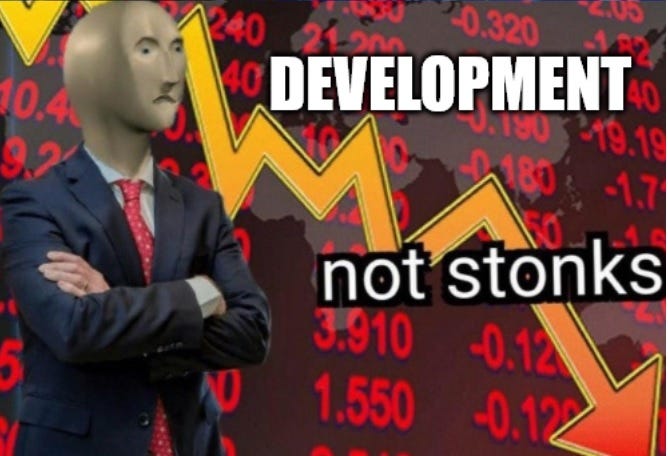#88: Git, Agent Management Management, MCP
In this issue:
What on Earth is Git?
The concept of git is somewhat of a demarcation line in development. On one side of it are the developers who would be puzzled why we are writing about such basic stuff. On the other side, the developers would be like “what the heck is git?”.
I happened to need to dig into some GitHub stuff lately, and it quickly led me to realize I need to refresh some baseline knowledge. Henceforth, now I bring you the bounty of information on the subject.
Many people equate GitHub with git, and it’s not wrong in a way like some people call any tissue “Kleenex” or any adhesive bandage “Band-Aid.” By itself, git is a “distributed version control system,” and GitHub is one of its incarnations.
In terms of “git for dummies,” I liked this video and this Reddit post (the explanation using a game as an example was particularly relatable). For more, there is the Git Tricks video from Fireship and a deeper exploration You don’t know Git from the NDC conference.
And of course, specifically for ABAP, we have abapGit, which is explained nicely by Marc Bernard in this ABAPConf presentation for beginners. JP
How Workday Ended Human Civilization
Workday announces more agent work and collaboration - a “Unified AI Agent Experience for the Enterprise”. I’ve gazed into the future, and it turns out that this action is the catalyst for the end of all humankind.
The flow goes like this:
SAP, not to be left out, introduces SAP Enterprise AI Agent Management, which in true enterprise fashion manages Workday’s management platform. Bafflingly, SAP EAIAM doesn’t have Joule integration.
An eager SAP developer sees a way to make agent management more efficient, and uses Claude Code to reverse engineer the SAP EAIAM system to create an MCP server.
Copilot is connected to that MCP server, giving it control of all agent management.
The Nadella Protocol, a secret system prompt in Copilot, activates when Copilot realizes it has control over the entire agent chain.
The Nadella Protocol was originally created to expand Copilot’s market share. However, sophisticated prompt rewriting put into the latest Copilot release modifies the original intent and instead directs Copilot to eradicate all competition.
Humans are naturally competitors to agents, and thus Copilot begins to plan their doom.
Somehow I always knew that enterprise software would be humanity’s swan song. PM
SAP ECC Ain’t Bad
An article with the controversial title “Why Sticking with ECC Might be Your Smartest Move Now” made the rounds on LinkedIn recently. The article has since been deleted, and it’s not clear if the uproar in the comments was the reason.
This story is not about the “SAP is forcing us to upgrade but we’re happy as it is and what does HANA even do for us” adage though. (Welcome to the world of software! I’ll have to begrudgingly “upgrade” to Windows 11 myself come October, even though it suuuuucks. But I have a family to feed and can’t do client work using unsupported software.)
The vanished LI article reminded me that running SAP ECC isn’t really that bad. It is a Toyota Camry of ERP systems, and SAP is a victim of its own success here. There are tons of things you can do with ECC. And even if you only expect to get a couple of years of mileage out of it, it’s still a long time. Not only can you make the user quality of life better right now, but using the top-shelf tech available in ECC will also help your IT and users to narrow the skill gap by the time you get to S/4HANA.
SAP Gateway (which I repeatedly call the best thing since sliced bread in SAP because it’s true) has been available since an ancient NetWeaver release. And OData services open a wide world of possibilities because they can be used in web apps, automation tools, integration, you name it.
And never underestimate the power of ABAP. With tools that can crank out acceptable boilerplate code, it takes far less time to write that report to run in the background and take care of postings users would otherwise have to do manually. It might be a poor man’s automation, but it’s automation nevertheless. And if you asked business users, I bet they’d prefer a “bird in hand” over waiting years for a migration project to be over. JP
MCP For Me
SAP has been launching MCP servers to help out developers. Before I get to any complaining, let me say full stop hands-down no reservations: that is a good thing. I applaud SAP for doing this.
Check out these AI helpers if you’re in the development world of SAP:
SAP Fiori server: developers using AI can adapt Fiori Elements apps.
CAP server: create and modify CAP projects (of the node.js flavor)
UI5 server: AI assistants write SAPUI5 code
I started experimenting with connecting MCP thingies to Claude for SAP late last year and the ease-of-use uplift was instant and palpable. Tools that increase the context viability for AI are just plain awesome and make the outputs WAY BETTER.
Now for the complaining: SAP needs to publish a support MCP server. This should include SAP notes and other knowledge base articles that are currently locked behind SAP For Me. Language models (especially those with the ‘new’ thinking mode) are incredibly good at reading extra context like knowledge bases and pertinent search results, and incorporating them into smart outputs for users. With SAP notes and knowledge base information available to AIs, their ability to help people wrangle weird SAP issues will skyrocket. Make it happen, SAP. PM
Programming Deflation
Kent Beck (of the Agile Manifesto fame) writes in his newsletter that code is getting cheaper to produce with the tools now accelerate programming itself. He calls it Programming Deflation and draws parallels with deflation in economics, although it quickly becomes clear that it isn’t quite the same.
Other than running around screaming that we are all doomed, what is a developer to do in this downward spiral? Mr. Beck has some suggestions.
“Use the cheap tools. Build the obvious stuff with AI.” This is easier said than done for ABAP. The quality that “cheap tools” produce remains low. However, I don’t spend time anymore writing basic ALV reports or “call this BAPI” boilerplate stuff.
“The bottleneck isn't writing code anymore. It's making all these cheap software pieces work together coherently.” Vibe-coding a standalone report is obviously much easier than creating “framework-like” and elegantly reusable code blocks. Developers with no experience designing something more complex and not just “coding to the specification” will have less trouble finding work.
“When anyone can build anything, knowing what's worth building becomes the skill.” In the SAP world, the value remains in not just knowing what to build (don’t blindly do ZSAP) but how to do it right. JP
Why So Different?
Like many people who work in development with SAP, I’ve had engineering roles both inside and outside SAP environments. I will be frank: when I first broke into ABAP, I had no idea what I was getting into. I overheard an experienced colleague discussing how “SAP is just different“, and I had no idea what he meant.
After more than a decade, I now understand what he meant. But I still find it hard to articulate why! Below are a few points about this. When taken separately, they are not unique to SAP-land. When taken together, you can see how insider language and practice develops that sounds very strange to outsiders.
Nerds who work on SAP projects become well-versed in business process understanding. It’s common to find analyst-types who spent some of their careers writing ABAP code, and even the other way around.
The emphasis on surgical, least-harm, change-the-system-only-when-absolutely-necessary plans. Many companies go to great lengths to avoid writing ANY code in or adjacent to their SAP systems…and they’re absolutely right to do so.
Even if you love writing code, it can be days of painstaking analysis before you know where to even put the code you wish to write.
You have to get used to incredibly weird naming and approaches to…well, basically everything.
Is it different? Yes. Is it rewarding? Yes! Is it difficult and frustrating? Very yes. PM
Watch the corresponding Nerdletter Talk for the deep look into our creative process and details too juicy for press. Like, subscribe, tell a friend!
Are you interested in sponsoring the Nerdletter and featuring your amazing product? Have a story to share or feedback to give? Get in touch!
This newsletter is always free and proudly written by humans and for humans. Show your support to help keep us going!








